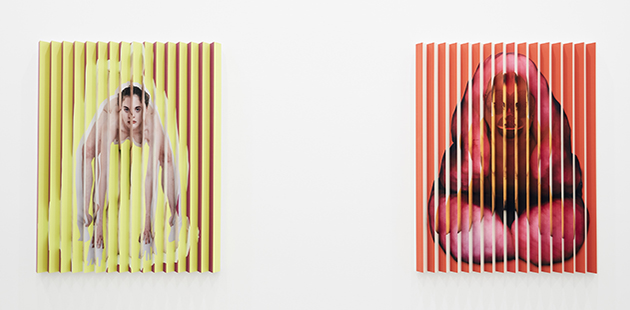 The National Gallery of Victoria presents an exhibition of new and recent work by renowned Australian artist Polly Borland, who is famed for her beguiling photographs of noted figures, including Her Majesty Queen Elizabeth II, musician Nick Cave and actress Gwendoline Christie.
The National Gallery of Victoria presents an exhibition of new and recent work by renowned Australian artist Polly Borland, who is famed for her beguiling photographs of noted figures, including Her Majesty Queen Elizabeth II, musician Nick Cave and actress Gwendoline Christie.
The exhibition includes 60 works spanning the last 10 years and reveals Borland’s celebrated ability to render the body in alluring, enigmatic and surreal compositions, often inviting the viewer to see the human form in unfamiliar ways.
A new tapestry work of Borland’s celebrated photograph of The Queen – taken for Her Majesty’s Golden Jubilee in 2002, is a highlight of the exhibition. The tapestry was created in collaboration with Fine Cell Work – an English prisoner’s advocacy organisation that trains prisoners to undertake paid, skilled needlework from their cells.
A further selection of tapestries based on Borland’s photographs are on display, presented double-sided to allow viewers to admire both the composition and highly skilled construction of the work.
The exhibition also includes works from several of Borland’s recent series, including Bunny, in which Gwendoline Christie’s distorted figure is used to subvert the idea of a Playboy bunny girl, and the carnivalesque Smudge featuring Nick Cave, in which her subjects – disguised by garish wigs, stockings and make-up – oscillate between the masculine and feminine, fantasy and reality.
In a mesmerising large-scale display, Borland showcases a new series of large lenticular works, taking the illusive quality of her portraits to new, three-dimensional scales. A never-before-seen body of new work, Morph – created especially for the NGV exhibition, is also on display.
“Borland shoots on film, taking many rolls to achieve the final images, and never altering the works in post-production,” said Tony Ellwood, Director NGV. “The works reveal Borland’s finely crafted skill for capturing uncanny moments that stretch our understanding of the human body.”
Polly Borland was born in Melbourne in 1959. After studying at Prahran College in 1983, she relocated to England in 1989 and to Los Angeles in 2011.
She established herself as a portrait photographer in Australia before shooting for numerous international publications including The New Yorker, The New York Times, The Independent and Dazed and Confused. Borland won the John Kobal Photographic Portrait Award in 1994, and the Josephine Ulrick and Win Schubert Photography Award in 2017.
In 2001 she was one of the eight photographers selected to photograph the Queen for her Golden Jubilee. Her first book The Babies was published by Powerhouse in 2001 and included an essay by the late Susan Sontag. In 2013, a documentary on the artist and her work, entitled Polymorphous, directed by Alex Chomicz, aired on ABC Television, Australia in March 2013.
Borland’s work is in public and private collections including The Andy Warhol Foundation for the Visual Arts, New York; National Portrait Gallery, London; National Portrait Gallery, Canberra; The Museum of Old and New Art, Hobart; and the National Gallery of Victoria, Melbourne.
Polly Borland: Polyverse
The Ian Potter Centre – NGV Australia, Federation Square, Melbourne
Exhibition continues to 3 February 2019
Free admission
For more information, visit: www.ngv.melbourne for details.
Image: Installation view of Polly Borland: Polyverse at NGV Australia: The Ian Potter Centre – photo by Tom Ross
